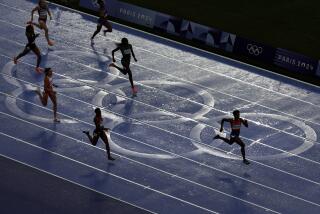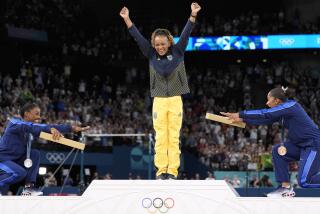Can Women Equal Men in Sports Events?
- Share via
When the question is raised, “Why can’t women be equals or better than men in athletic competition?” the battle lines are drawn very quickly.
“It’s largely a psychological barrier women have to overcome in order to achieve the sports performances of men,” says E.C. Frederick, Ph.D., biomechanist and director of the Exeter Research Lab in Brentwood, N.H. “I think that the differences between top female and male athletes are cultural in a lot of respects. In the past, women were told that sports wasn’t for them. It followed that they weren’t offered the same athletic opportunities.”
Frederick believes that in time, and this could be in 100 years, as women’s participation in sports becomes more accepted in society and more coaching and training opportunities are made available earlier, women could become equals or even better than men in some events.
Christine L. Wells, Ph.D., professor of exercise science at Arizona State University in Tempe, and author of the authoritative book “Women, Sport and Performance” (Human Kinetics, $24), rejects Frederick’s “cultural” theory to explain differences between top male and female athletes. “You will find cultural differences in the weekend athlete crowd where there might be a 25 to 50% difference in athletic capability between the men and women,” Wells says. “But with elite athletes with similar training and coaching, the differences are much lower--but still there.”
Physiological Basis
The reasons for this disparity, Wells explains, are strictly physiological, not cultural. A man is simply inherently stronger, and this one factor is what will enable him to regularly defeat a woman.
Since the 1970s, the gap in performance standards and world records between men and women has closed considerably in almost every sport. By 1984 top women athletes were within 92% of the men’s record for the 100-meter dash and within 90% of the men’s marathon (26.2 miles) mark. In swimming women were approaching 90% of the men’s 100-meter freestyle best and up to 94% of the 100-meter butterfly record.
While Wells thinks women will still improve and continue to chip away at the men’s lead even more, she doesn’t believe women will ever completely close the gap. Frederick, however, expects that eventually there might be parity between the top male and female athletes.
“Emil Zatopek of Czechoslovakia won the gold medal in the marathon in the 1952 Olympics (2:23:03) and Alain Mimoun (2:25) of France won in 1956. Both would have lost to Joan Benoit in the 1984 Olympics (2:22:43),” says Frederick, “Joan is just a much better runner than those men and better than every male marathoner in history before 1956.”
According to Frederick, the reasons for the emergence of the female athlete are threefold. “You have many more women competing than ever before, which then inspires other women to compete,” he says. “This builds up a larger talent base. Women are also putting in longer training hours.”
“I train as hard, if not harder than a man,” says Mary T. Meagher, the current world record holder in the women’s butterfly.
“While some men swimmers have a tendency not to work as hard in practice, I think women in general are a lot more diligent. Swimming is a technique sport and women work on that more than men, who tend to rely more on their strength.”
Female swimmers are turning in times that are comparable to what men were doing 10 years ago. “You can’t attribute all of this to training,” Frederick says. “I think that psychologically women are finally realizing that they can go faster, compete at a much higher level.”
One woman who has trained right alongside men for most of her athletic career, and more recently has competed against them, is Nancy Lieberman, considered by many to be the best woman basketball player. Last year Lieberman played in the U.S. Basketball League, a summer circuit for marginal NBA players and promising rookies. For three months before her first team practice, Lieberman worked out on her own.
“You’d never have known that I’d done anything to prepare if you saw me going against the men on the first day of practice,” Lieberman said. “Guys came to camp half in shape, but still they just blew right by me. There were quicker, had more explosive power and were stronger. It was really distressing.”
Still, 5-foot-10 Lieberman managed to hold her own. Although she only averaged 2 points a game, she was second on the team in assists and was looked to for court leadership.
“The beauty of women’s sports is what’s going to be happening in 30 years from now,” Lieberman says. “Down the road we’re going to get much better female athletes. But as we get stronger, bigger and faster, so will the men.” Wells agrees. “Although the gap in performance is narrowing, the difference in records should always remain at about 4 to 6% because of the physiological differences. A top female athlete has a lower oxygen capacity. She will also have more body fat and therefore a lower percentage of muscle tissue than a man of the same weight.”
Many top women athletes accept the notion that they’ll never be the athletic equal of a man and for them, it’s not an issue of any import. “I think we’re starting to close the gap with the men as far as notoriety and public acceptance are concerned,” says Jackie Joyner-Kersee, the world record holder in the heptathlon. “And this is a more important issue for women. I may do 24 feet in the long jump and Carl Lewis does 28 feet. My goal isn’t to defeat Carl or any other man, but only to do as well as I can against other women. My talents will hopefully motivate other girls and women to compete.”
“The bottom line is that women are different than men,” says Wells, “and you have to accept them for what they do.
“And even though women are lacking the power and strength of a man, they still do very well. This may mean that women are actually achieving more of their athletic potential than men.”
The Women’s Sports Foundation was founded in 1974 to encourage and support participation of women in sports, to increase the opportunities for females and to educate the public on the mental and physical values in sport and fitness. The foundation is a ready resource and welcomes questions about training, sports leagues, sports injury prevention and college scholarships. For information, contact the foundation at 342 Madison Ave., Suite 728, New York, N.Y. 10017 (212) 972-9170.
More to Read
Go beyond the scoreboard
Get the latest on L.A.'s teams in the daily Sports Report newsletter.
You may occasionally receive promotional content from the Los Angeles Times.






